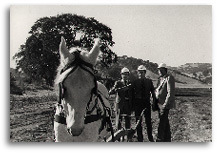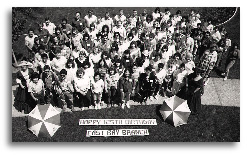Groundbreaking for the new Fireman's Fund headquarters in Novato, 1980.
No copyright indicated.
Reference 4-1-3-6-358, 0338.
 |
|
East Bay Branch employees celebrate Fireman's Fund's 125th anniversary, 1988.
No copyright indicated.
Reference 4-1-3-10-4, 0536.
 |
|
- 1980
- Fireman's Fund implements a strategy to help agents and brokers increase production through better service, better communications, better producer training and better marketing programs.
- Commercial insurance continues to be the mainstay of the company's business doing 75% of the company's business.
- Workers' Compensation generates the company's largest premium volume.
- Fireman's Fund implements a market segmentation program is used to identify a growing market; determine the needs of consumers; independent agents and brokers and adapting the company's strengths to meet those needs.
- Commercial Lines upgrade its industrial hygiene capabilities. It introduces analytical consultation services in the areas of occupational health and air and water pollution.
- Commercial Lines develops a highly-specialized condominium policy.
- National Accounts and Risk Management Services focus on the needs of large companies and organizations with substantial exposure and complex operations.
- Commercial Group designs insurance for trade associations, franchise groups, dealer organizations and similar groups.
- Rural Markets Department is established to serve producers in rural markets.
- Fireman's Fund writes its first account as the exclusive North American affiliate of the International Network of Insurance, a consortium of 15 prominent European insurers.
- 1981
- Fireman's Fund continues professional development activities for producers.
- Fireman's Fund creates a subsidiary, Agency Automation Services Inc., to develop and market a system that will automate all the back office operations of an agency.
- Specialty lines operations are combined with National Accounts and Risk Management Services.
- Fireman's Fund Risk Management, a wholly-owned subsidiary, becomes operational and provides field claims adjusting services, claims file audit, rehabilitation nursing services, industrial hygiene field surveys.
- Fireman's Fund's fastest growing division is Excess Property. Uncommon coverage includes electronic data processing errors and omissions; broadcaster, newspaper publisher, advertising agency and advertiser liability; product withdrawal expense; and hole-in-one golf tournament coverage.
- Fireman's Fund insures 11 of the 27 films nominated for academy awards including "Ordinary People," which wins best picture and "Raging Bull," which wins four awards. Excess and Special Risk has provided insurance coverage to the entertainment industry for 25 years.
- 1982
- Edwin Cutler becomes chief executive officer, Jim Meenaghan is elected president and chief executive officer of Property Liability operations and a director of Fireman's Fund.
- Fireman's Fund introduces American Business Coverage (ABC), a total account program for small businesses.
- Fireman's Fund introduces the Hobby Farm Policy for the gentleman farmer.
- Fireman's Fund develops an insurance policy for ABC TV's coverage of the Olympics against losses resulting from cancellation or postponement of the 1984 Olympics caused by political disturbance or natural disaster.
- The Claims Department processes more than one million claims (4,000 per day).
- San Francisco Reinsurance Company, Fireman's Fund's multi-line property liability reinsurance subsidiary completes its first year.
- Underwriting losses skyrocket and new reserves are set up to cover the claims. Fireman's Fund tries to earn larger profits by underwriting riskier claims.
- October: Fireman's Fund moves its home office from San Francisco to Novato, California.
- 1983
- Fireman's Fund buys ARC automation services, which markets computer programs and systems for insurance producers.
- Development of CIS, a computer system that automates the job of rating, issuing and endorsing commercial lines policies, continues.
- September: The Wall Street Journal reports Fireman's Fund is a drain on American Express. Fireman's Fund reports a fourth quarter loss, the first in 36 years.
- Sanford Weill, president of American Express, and William McCormick are asked to salvage operations. Weill replaces Cutler as chairman and chief executive officer and McCormick becomes chairman and chief executive officer of US Property Liability over Meenaghan, who remains president of Property Liability.
- November: Fireman's Fund buys Aetna's loss reserves and assumes Aetna's old risks.
- 1984
- Speculation continues that Fireman's Fund manipulated earnings to post favorable earnings.
- 1985
- June: Fireman's Fund announces restructuring. The life insurance business is transferred to American Express, and American Express develops a public market for the remaining property casualty activities, thus returning Fireman's Fund to its former structure as an independent company.
- July: Fireman's Fund announces it is strong financially in spite of a net loss of $72 million for the second quarter.
- John Byrne replaces Sandy Weill as chairman and chief executive officer of Fireman's Fund Insurance Corporation, a holding company.
- October: Fireman's Fund stock worth $824 million is sold. (largest in the nation's history since Ford went public in 1956).
- Losses in the first half of the year overshadow the profits in the second half. Commercial insurance continues to be the mainstay of Fireman's Fund.
- Fireman's Fund employees 48 branch offices and 8,900 agents and brokers.
- Ocean Marine continues to be one of the leaders of import/export cargo coverage.
- 1986
- William McCormick announces the successful turnaround of Fireman's Fund and the next phase of organizing around markets and improving efficiency and controls. He announces the creation of three market-based companies within Fireman's Fund.
- The special investigation unit (SIU) is launched. Its purpose is to investigates suspicious claims.
- 1987
- Fireman's Fund reorganizes insurance lines into three areas: commercial, personal and specialty.
- 1988
- November: Proposition 103 is approved by state voters in California, which involves a rollback of auto insurance rates.
- Fireman's Fund celebrates its 125th anniversary.
- 1989
- Jay Brown is elected president of Fireman's Fund.
- October: San Francisco Bay Area is hit by an earthquake. Fireman's Fund offices are not damaged.
|